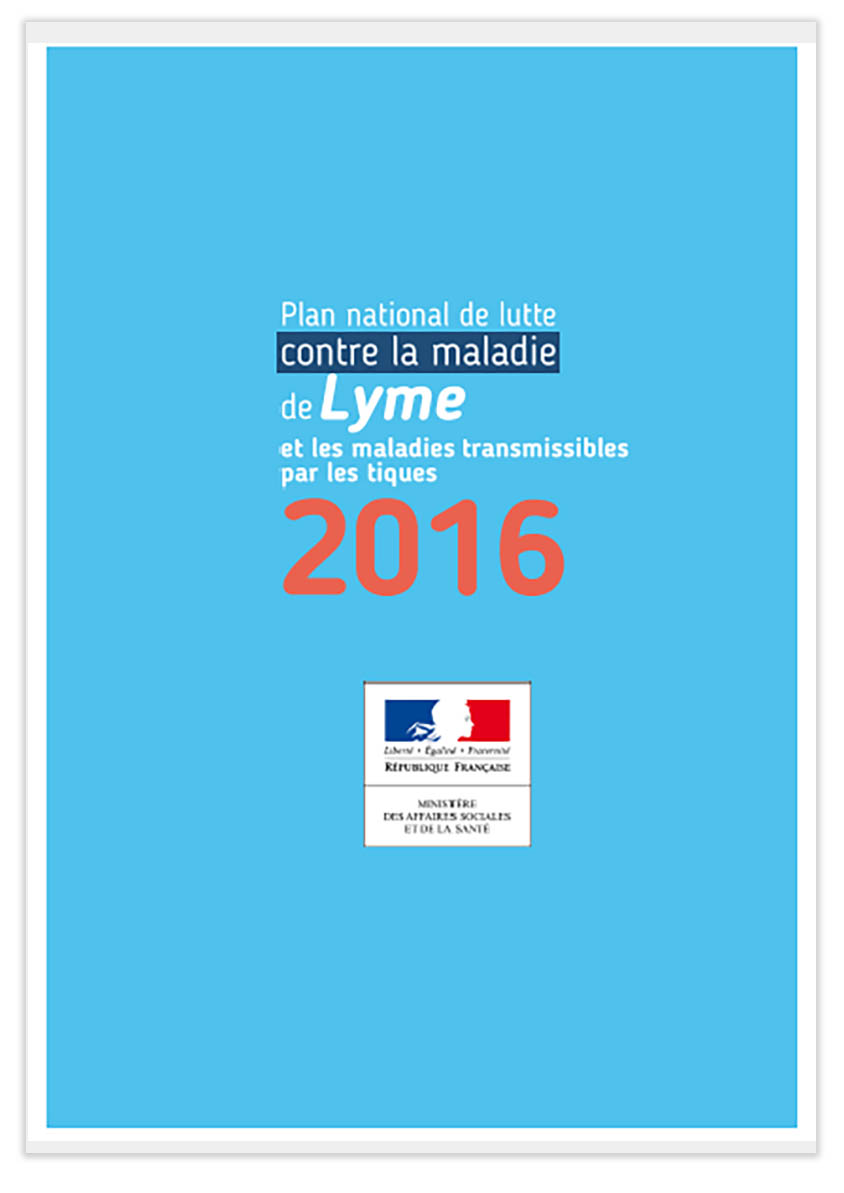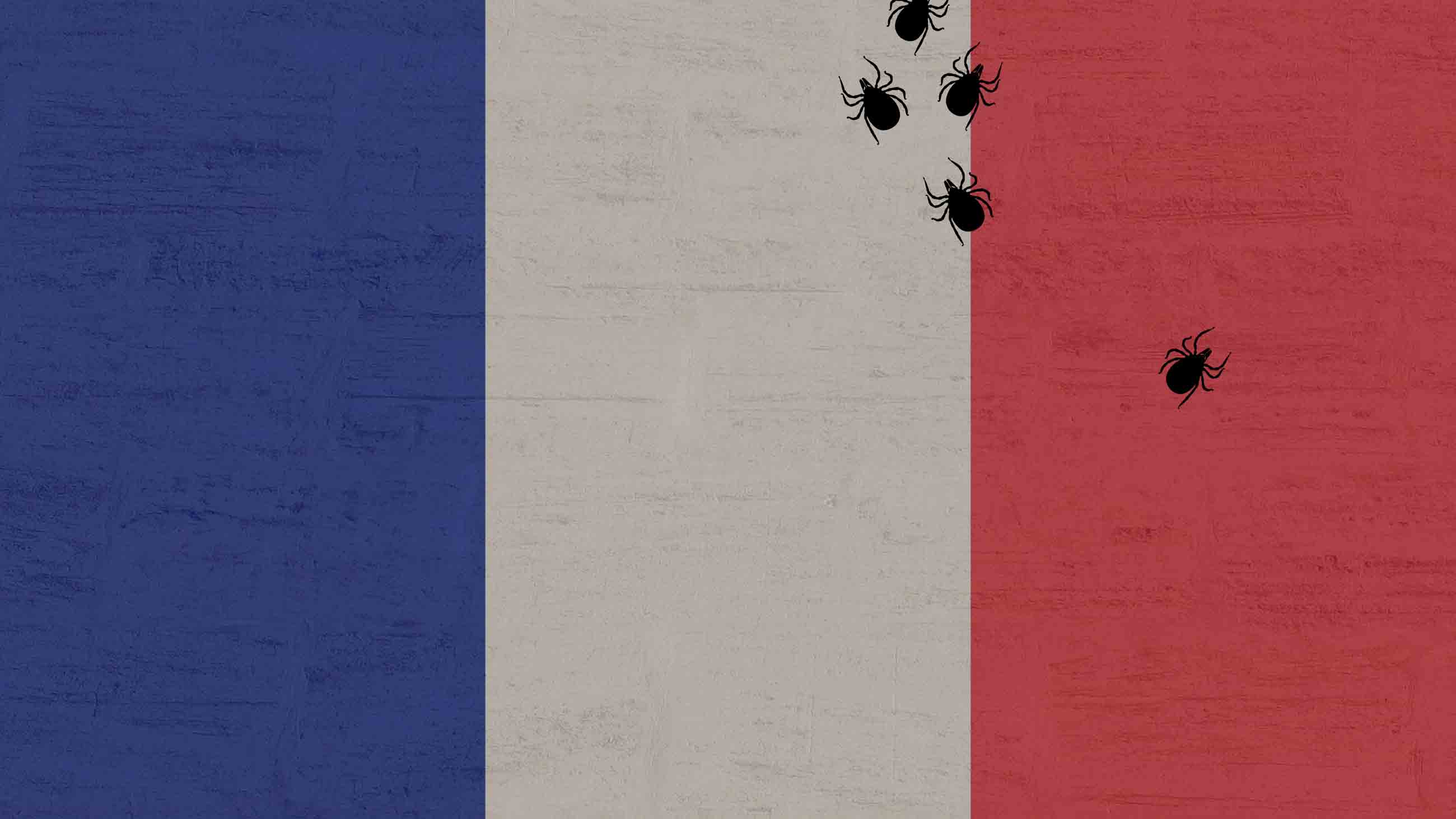In France’s Battles Over Lyme Disease, Lessons in Science Communication
“What’s your position on Tic-Tox?” Bruno Titotto asked while seeing Dr. François Goehringer, an infectious disease specialist, for the first time. We are in a new specialized Lyme disease clinic in Nancy, in northeast France. Tic-Tox is an alternative treatment of “essential oils,” marketed to those who believe they have a chronic form of Lyme disease. It was pulled from the French market in 2012 by a regulator for safety concerns, and Titotto’s question was not an innocent one. He was essentially asking Goehringer which side of the chronic Lyme debate he was on.
Titotto, a 30-something native of Lorraine, which has one of the highest rates of Lyme disease in France, has had odd symptoms for years: joint pains, intense fatigue, and difficulty with balance and memory. After searching on the internet, he thought something called chronic Lyme disease — a nebulous condition not recognized by most physicians — might explain his current symptoms. But his blood tests don’t offer a clear diagnosis.
“I’m not sure if what you have is really Lyme,” Goehringer told him.
That answer is unsatisfying for the legion of French citizens who have become convinced that chronic Lyme disease is real, and that doctors and scientists are flat out wrong. To fight this, the French government released a national plan to combat Lyme last year that included a fact-based public service campaign aimed at raising awareness about the disease’s real prevalence, and, it was hoped, dispelling misconceptions about chronic Lyme.
It didn’t work. Rather than quelling the swirling controversy, the strategy, which included radio spots and other media messages, has only served to further entrench the suspicions of the patient community.
The ongoing information struggle in France provides important lessons that reach well beyond Lyme disease. From climate change to the anti-vaccine movement, motivated reasoning, confirmation bias, and “fake news” are challenging scientific consensus, with increasingly concerning results.
A fact-based approach is often standard procedure in public health awareness campaigns, but on contentious or political topics — and with Lyme in particular — France’s experience demonstrates that strictly fact-based messaging can backfire. And that’s because beliefs about Lyme are not just tied to knowledge or misinformation, but to far more rooted things like culture, values, and identity.
Spread by ticks, Lyme is easy to treat in its early stages. “Chronic Lyme” emerged when patients complained of persistent symptoms despite appropriate treatment. Unable to convince doctors of their continued suffering, many patients were essentially dismissed, or, worse, told that their “medically unexplained symptoms” were psychological in origin.
Let down by mainstream medicine, patients sought care elsewhere, particularly with Lyme-literate physicians, sometimes called LLMDs — a shibboleth indicating a willingness to test and treat outside of the guidelines from the Infectious Disease Society of America (IDSA).
The IDSA’s 2006 guidelines still set the standard for testing and treatment of Lyme (they’re currently in revisions,) and are very similar to French testing and treatment guidelines from the same year. IDSA’s guidelines have been reviewed by the CDC, and by equivalent boards in France, Switzerland, Canada and the U.K. as recently as 2016, all of which agree with the main recommendations. To doctors, this signals consensus; to Lyme advocates, conspiracy.
That’s because a number of mysteries and uncertainties still surround Lyme and are under active research — though Lyme advocates consider these hotly debated questions to be settled and regard the IDSA guidelines as cruel. They advocate for the use of private tests not approved by government regulators and tout alternative guidelines that allow for antibiotic treatment well beyond the standard maximum of four weeks despite high-quality scientific evidence showing no benefit.
During the summer of 2016, the Lyme debate reached a fever pitch in France as the press exploited the controversy. As just one example, L’Obs, a popular weekly magazine, dedicated its July issue to the disease with the cover story titled “The Epidemic That’s Hidden From You.” Articles featured the unchallenged opinions of Dr. Christian Perronne, a French physician whose recent book “The Truth About Lyme Disease” presents many interesting but highly uncertain hypotheses about the causes and cures of chronic Lyme. Perronne was one of 100 physicians sounding the alarm that the health ministry must act fast.
In fact, France has fewer estimated yearly cases than the state of Massachusetts, despite a population 10 times the size, and that number has been stable at around 29,000 cases annually since 2009. (Massachusetts sees an estimated 40,000 to 50,000 cases each year.) But France released its national plan, in part, to assuage the concerns of a highly active advocacy community of people convinced they are affected by chronic Lyme disease. While the plan itself is well designed, Lyme advocates have not been placated — and a poor communication strategy is partly to blame.
In July, the health ministry released a set of 10 radio spots featuring prominent French scientists answering questions on ticks or Lyme based on current scientific consensus. Le Droit de Guérir (“The Right to Heal”), a patient advocacy group, demanded the radio spots be pulled, arguing that broadcasting them was “dangerous” because the experts featured “are detractors of the chronic form of this illness.”
The spots ran anyway, but rather than quieting the concerns of Lyme advocates or finding common ground, the national plan seems to be further entrenching the two extremes. The backlash is not limited to disputed facts, and some activists dismiss even the most innovative parts of the Lyme plan, like Goehringer’s Nancy clinic, a multidisciplinary one-stop shop for diagnostic testing and treatment for Lyme.
“The multidisciplinary centers are the powder in the eyes to calm public opinion,” one commenter on a Lyme advocacy website wrote. “One day the truth will burst out.”
In their book “The Enigma of Reason,” cognitive scientists Hugo Mercier and Dan Sperber describe what they call the “my-side bias” — the tendency of individuals to unconsciously select for information that confirms their existing opinions. In theory, such individual biases can be counteracted through training people to be aware of how they process information.
But there’s also a social aspect that reinforces individual biases. Daniel Kahan, a law professor who runs the Cultural Cognition Project at Yale Law School argues that resistance to certain truths is common in part because new ideas force people to re-evaluate their identity, and that in turn, could possibly alienate them from valued social groups — something he calls “identity-protective cognition.” Training individuals about bias can help, Kahan argues, but changing minds requires providing information in ways that do not threaten cherished identities.
Kahan’s work on climate change has shown that while people agree to defer to experts in theory, in practice they only do so if the expert shares their group’s position. So it may not be surprising that Lyme advocates rejected the experts picked for the radio spots. They might be experts, but they are not their experts.
Moreover, blindness to the values and motivations that drive these beliefs helps explain how fact-based teaching on contentious political issues can actually backfire. In the case of vaccine refusal, parents that are most resistant to vaccines become even more resistant after having their beliefs debunked, despite the use of varied communication strategies. Facts only matter if you trust their source. The physicians and public health professionals who have already lost the trust of Lyme patients are unlikely to be convincing just by citing more facts.
And yet so far, that seems to be the main response of the French scientific community. The editor in chief of Science & Pseudo-sciences, a popular science magazine published by the French Association for Scientific Information wrote a scathing criticism called “Lyme Disease: Between Psychosis and False Information,” followed by an article in a French medical journal exposing “The Hidden Face of Lyme Doctors.” Another popular science magazine, Sciences et Avenir, also recently highlighted some expensive but unproven treatments marketed to those with medically unexplained symptoms who believe they’ve been affected by chronic Lyme disease. A documentary film ran on French television in May with the foreboding title “Lyme Disease: Epidemic or Psychosis?”

The French national plan requires physician experts and patient advocates to work together to develop new clinical guidelines to treat Lyme. But the original release date of June 2017 has come and gone without consensus.
Framed as “belief in science” versus “psychological illness,” the tenor of these inquiries, while factually accurate, doesn’t help. With such inflammatory language, it is no surprise that the two sides are entrenched in an irreconcilable debate. This poses a particular problem for the part of the French national plan that requires physician experts and patient advocates to work together to develop new clinical guidelines to treat Lyme. Despite monthly meetings, the original release date of June 2017 has come and gone without consensus.
Both sides are up in arms about the process. Patient advocacy groups have complained about the lack of transparency and the slow speed. Lymaction, an advocacy group, denounced the process as a “communication exercise.” After word that a consensus could not be reached by the original deadline, the French Association for Scientific Information expressed concern that civil society groups were hijacking the process, saying, “medicine should be based on rigorously validated scientific facts, not on the pressure of opinion or power relations.”
Consensus will likely remain elusive as the group meets through the fall. Like Tic-Tox, treatment guidelines are the fault line that divides chronic Lyme advocates from the mainstream medical community. Dr. Yves Hansmann, an infectious disease physician at the University of Strasbourg and participant in the process, says “what’s left to discuss is mostly chronic forms [of Lyme], where we have the risk of having difficulty to reach an agreement because we have very different opinions.”
Kahan’s solution is finding compromises that do not threaten the identity of various stakeholders. One approach for vaccine skeptics, suggested by Mark Navin, a philosopher at Oakland University in Michigan, is to seek the first-hand experience of patients and parents to help prioritize the research agenda. A similar approach might work for Lyme advocates.
An even better approach would address the underlying problem. Most people who come to specialized clinics concerned they have chronic Lyme do not meet criteria for the disease. But many are still suffering. A patient-focused research agenda might finally address the true epidemic of “medically unexplained symptoms” — the patients with “none of the above” syndromes that are too frequently dismissed by mainstream physicians for their medically unexplored stories.
Shawn Otto, in his book “The War on Science,” suggests that there is no shortcut to the hard work of correcting misinformation. It takes time to gain an individual’s trust and respect and walk them through the scientific process so they see why, despite the complexity, there is consensus rather than conspiracy.
After Titotto asked Dr. Goehringer about Tic-Tox, there is no avoiding a discussion about alternative therapy. Titotto is searching for solutions and he is more concerned with feeling better than acquiring a precise diagnosis: “I couldn’t care less if it’s Lyme,” he told the doctor.
The discussion turns to Dr. Christian Perronne, the author of “The Truth About Lyme Disease,” and the long-term antibiotics he advocates as treatment for chronic Lyme. “The studies Dr. Perronne cites are often lower quality,” Goehringer says. High quality studies are randomized with control groups, to be sure the intervention is really working, he explains, but Perronne often puts heavy emphasis on non-randomized, retrospective studies without controls.
After more discussion, Titotto says he understands not all published science is of equal quality. But he is quickly overwhelmed: “You cite scientific articles, he cites scientific articles,” Titotto says. “How do I balance between the two?”
Reporting for this project was supported by the Pulitzer Center for Crisis Reporting. David Scales is an internal medicine physician at Cambridge Health Alliance and an instructor at Harvard Medical School. He can be found on Twitter @davidascales.











Comments are automatically closed one year after article publication. Archived comments are below.
Sending Prayers, after my Lyme Disease diagnosis, my rheumatologist was very open when looking at alternative medicines and procedures, with his guidance i started on Lyme disease Ayurvedic treatment from Natural Herbs Centre. The treatment worked very effectively for my Chronic Lyme, most of my severe symptoms simply vanished within the first 3 months on the treatment, i feel better now than I have felt in years and i can feel my strength again. Visit Naturalherbscentre. com Remember you are not fighting alone
Doctors dismissing people with ongoing symptoms just b/c they attribute the symptoms to a disease the doctors don’t think exists is wrong. The # of sufferers is high enough to say, that SOMETHING must be causing this, & this refusal to investigate real symptoms on ideological grounds is just wrong. Maybe “chronic lyme disease” doesn’t exist, but SOMETHING must be causing its symptoms.
The sources for the provided article support the persistent symptoms after treating LD, and not the evidence of a persistent infection. In either case, we need to know for sure.
This article is regrettably poor. Unlike most physicians and researchers on Lyme, i have, in the past 12 years, read over 35,000 peer reviewed journal articles either directly about Lyme associated research or about aspects of that research that the journal articles raised as of interest. As well, I have had contact with some 25,000 people suffering from Lyme over that same time period. I have also written the most definitive text, correlating all that data, that now exists on the history, nature, dynamics in the ecosystem, both micro and macro, and the subtleties of its inflammatory dynamics in creating disease. Further, i examined, in depth, the actual data in all those journal articles on Lyme disease. Contrary to the article’s author, antibiotics are not a sure fire treatment for Lyme infections. Many studies do show effectiveness when antibiotics are first administered but there is as much as a 40% relapse rate, also well-described in journal studies. Even by the most optimistic studies, antibiotics are only 99% effective (this does not allow for relapse later). That still leaves one percent of those infected that do not get well. Borrelia bacteria are stealth organisms. They are very good at hiding in sequestered niches where antibiotics cannot reach them, such as inside our own cells. They are very old organisms and highly adaptable. They are masters at subverting cellular function for their own ends. Commonly, they break down cellular structures to obtain the nutrients they need to survive; they are parasitic organisms. Journal studies reveal that there are two conditions that commonly continue after the original infectious stage. The first is more properly called post-lyme disease syndrome, a condition in which the damage the infection caused is not being repaired by the body and in which fragments of borrelia organisms or cellular debris similar to those organisms or simple cellular debris from cell breakdown during infection continue to cause problems. In this instance there is no active Lyme infection though the symptoms may be very similar to infection. In the second case there are still Borrelia organisms present in the body, in low numbers, in protected niches where they continue to damage the body’s cellular tissues. One of the real difficulties in Lyme disease is that symptoms are often caused by very low numbers of the organism; they aren’t readily found by most tests. Further, the organisms are highly adaptable, they continue to alter their exterior protein coat, which makes them harder for the immune system to see, reproduce many variants of themselves all of whom possess slightly to very different genomic structures, and they learn as they go – they learn the particular bodily ecosystem they are in and adapt to it and our immune responses. Antibiotic treatment is simply not up to the task of treating stealth infections as they are with acute infections such as strep or staph (and in this statement, i don’t look at the resistance dynamics that are altering those microorganisms to the extent that antibiotics may not be useful at all in the coming decades). None of what i am saying here is news, it is carefully concealed in open access peer review journal articles. The problem, in every country, is that physicians virtually never have or take the time to read those articles in-depth; they just don’t do the research. Further, after 40 years of experience with technological medicine, in all its aspects, they rarely understand that they are in service to the ill and their job is to figure out what is wrong and to treat it. That demands continual education, a sense of humility, and an ability to serve. I truly wish that writers such as this one, who approach the subject with a preset bias, would simply do the research that complex, ecologically driven diseases demand to understand. I also wish they would understand that there are many problems in both science and medicine the way they are currently practiced and do some depth reading in this area. Recognizing that such problems exist does not make one anti-science or anti-medicine but rather allows the development of intellectual integrity, the ability to question and look deeply, without surrendering those qualities to mass thinking, something science and medicine have always had trouble with. Oh, and regarding Christian Perronne, any superficial search would turn up his credentials, which are, by scientific and medical standards, exemplary. The way the article is written is as close to directly attacking his reputation as one can get without overtly crossing the line. Should the writer have any attack of conscience, here is a link that outlines his credentials and experience: https://ww2.eventrebels.com/er/CFP/AgendaAtAGlance.jsp?CFPID=690&ScreenID=331&DisplayPresenterID=119438&DisplayProgramItemID=110405&DisplayProgramSessionID=40197&Token=HCMTJS4F6&PreviousScreens=326
Mr. Buhner,
Thanks for your comment, and while there is much that I disagree with you on, we both can agree that “[physicians] rarely understand that they are in service to the ill and their job is to figure out what is wrong and to treat it. That demands continual education, a sense of humility, and an ability to serve.” I also agree that cognitive bias is a significant problem – many people read the scientific literature and come to different conclusions because of it.
Our disagreements seem to lie in how we weigh and accept evidence. I, too, have read thousands of scientific papers. The question is not how many papers I have read (or you have read), but what distinguishes the quality of one paper from another?
I put high value on studies that are randomized, blinded and with placebo controls. Antibiotics have been repeatedly proven with high quality studies with this study design. The herbal medicine that you promote on your website and in your books may help some patients (I don’t doubt that), but it is difficult for a physician to recommend such herbal treatments broadly until there is more of a high quality evidence base to support it. I get especially concerned when people forgo treatments for which there is high quality evidence and instead turn to treatments for which there is little evidence because someone convinced them it would be better.
I worry that your evidence base is more like Christian Perronne’s, which he describes in his recent book, which I encourage you to read along with a very good review: http://www.pseudo-sciences.org/spip.php?article2875. Like you, he also has interesting theories about diseases, namely the idea that crypto-infections may cause everything from Lyme-like symptoms to autism or alzheimers. You may criticize me for taking him to task, but he marshals little evidence to prove this beyond his anecdotal experience. He claims his theories are valid not because they have been tested and high quality studies have proved them to be so, but because he has seen the results with his own eyes. I don’t care what your credentials are or how many papers you’ve read – if the treatments you’re offering haven’t been studied in high quality trials, I will remain very skeptical of them. Given how many papers you’ve read, I would hope you would too.
This paper is a bullshit !
Chronic Lyme disease is a real problem for patients without results after standard antibiotherapy. Because Borrelia and several co-infections can persist in the organism.
According to GRADE project guidelines in England, the evidences are based on low or very low quality of evidence in all questions formulated by the panel. Yes … LOW or VERY LOW quality ! In this contexte, why the specialists in infectious diseases and other experts can claim we have good science to diagnose and cure this disease ?
For more information about this project, see : https://www.nice.org.uk/guidance/indevelopment/gid-ng10007/consultation/html-content-2
The thesis that there is a communication crisis is deeply wrong. These specialists and experts have found a strategy to discredit Doctors who follow chronic patients et their patients themselves.
More and more evidence supports complexity and chronicity, according to this systematic review :
https://www.hindawi.com/journals/ijfm/2014/138016/
But we have no robust randomized clinical trial who supports this thesis. We need to finance a independant, transparent research to solve uncertainties. It’s a urgent for many patients, abandoned by the classical medicine. You have an physiological problem and the Doctors will diagnose stress, burn-out, somatization or psychiatric problems ! But where is the Hippocratic Oath
Dude is not only not qualified to be talking about Lyme (has no science background) but he went to Yale (the primary perpetrators of the Lyme and LYMErix crime) and the CDC (CDC officers own the useless tick borne disease patents and performed the Dearborn stunt). See more at truthcures.org/charge-sheets or ActionLyme.org for the science and the details.
Hi Kathleen,
Thanks for your comment. I hope going to Yale or having worked at the CDC doesn’t disqualify all experts in your eyes — that would be a lot of people! I’m sad to see that much of my biography that you cite is incorrect, and the truth would be easily verifiable by a google search or a glance at my Linked-In profile. Since you’re an analytical chemist, I thought you’d at least approve of my chemistry background?
You do raise an interesting question about who is qualified to be an expert. I believe patients have a unique expertise that should be shared and can help set research priorities, but aren’t necessarily. I spent 14 years in post-graduate education, so I’m also pretty personally invested in the idea that expertise can be gained through more education, but degrees don’t make experts either.
To me, it isn’t necessarily because the facts memorized that gives one expertise, though that is important, but education teaches you a certain process of thinking that helps weigh evidence and avoid bias. Many people I’ve talked to about Lyme can cite a lot of facts or link to lots of papers, but have difficulty identifying bias and motivated reasoning in their own analysis of all the data.
From what I can see, you’re idea of an expert seems to be associated with distance from the “perps” at Yale and the CDC that discuss views different from yours. That seems more like a litmus test of expertise based on pedigree and belief, rather than weighing evidence. Would you like to explain in more detail?
It is disappointing that an article that is about how to do effective risk communication, a 40+ year old unique communication discipline that specifically deals with challenges like this, includes nothing about risk communication per se, nor anything from the several prominent risk communicators whose expertise might have helped this essay more productively answer its central question. Nor does it include anything from the research on risk perception psychology that in addition to Kahan et al helps explain the emotions and fear in this instance.
I’d be interested in learning more about the risk communicators if you were to cite a few, as well as some of the research on risk perception psychology?
I understand what this guy is saying, BUT the husband of our neighbor in France got Lyme disease, and he NEVER got better. He couldn’t stand the years of suffering and eventually committed suicide… Something is obviously wrong!!
I’ve suffered from Lyme disease since childhood (80’s), and I’ve seen numerous doctors and specialists, they have always said I’m making that up, I have nothing. That’s medicine in France! They laugh at you and leave you untreated! 40 years of suffering! I understand why so many suicides!
I see France has their own indoctrinated Lyme War. Good! The French people deserve Truth and Justice as well. Lyme AIDS Victims should get their Science from the Spaniards as well as hundreds of published articles telling the truth of Epsteins Borreliosis AIDS Pandemic. Undark the historical chicanery of Spirochetal Disease. After all infinite antigenic variation is a never-ending foe.
https://m.facebook.com/story.php?story_fbid=10207454356991238&id=1657389649
Are you serious to write that ?
Iv been sick for 14 years and I didn’t know what happened.
After dealing two years with antibiotics, I feel like a new man.
Guess what ? It was lyme disease and my test was negative.
Sorry but you have to search a little bit more than your certainty.
Best regards
Dr Scales at it again… Saddening…
Will you call this quakery?…
Proof that chronic lyme disease exists
https://www.ncbi.nlm.nih.gov/pubmed/20508824
Commercial test kits for detection of Lyme borreliosis: a meta-analysis of test accuracy
https://www.ncbi.nlm.nih.gov/pubmed/27920571
Drug Combinations against Borrelia burgdorferi Persisters In Vitro: Eradication Achieved by Using Daptomycin, Cefoperazone and Doxycycline
https://www.ncbi.nlm.nih.gov/pmc/articles/PMC4373819/
Characterization of Biofilm Formation by Borrelia burgdorferi In Vitro
https://www.ncbi.nlm.nih.gov/pmc/articles/PMC3480481/
What do you have to say from the amount of scientific references listed here?
https://www.facebook.com/drrichardhorowitz/posts/1524119334343526
This is not funny, people are dying, you know…
How Lyme disease might be triggering hundreds of suicides
https://www.usatoday.com/story/news/nation-now/2017/07/19/how-lyme-disease-might-triggering-hundreds-suicides/493934001/
This is a comment that I published in one of your previous articles on a different web site, that was withdrawn:
—————
Dear Dr Scales, although I might have sounded harsh in my words, I stand by what I wrote. These are a few comments:
“which has France’s leading Lyme scientists answering questions about the disease – can you cite your evidence?”
Again, I disagree. A leading scientist needs a critical mindset and only should trust scientific evidence.
Regarding the radio messages, here they are: http://inpes.santepubliquefrance.fr/10000/themes/maladies-tiques/tiques-outils-information.asp however it seems the page was removed, maybe due to patient’s anger through Lyme societies. Here are some points which are wrong in these audio messages:
On “Qu’est-ce-que la maladie de Lyme” (What is Lyme disease)
They say “You get Lyme from a tick bite”
-> You cannot just say that, there are other ways of catching Lyme disease:
Horse-flies, e.g. https://www.arminlabs.com/fr/services/tick-borne-diseases/lyme-borreliosis
Mosquitos, e.g. http://www.sciencedirect.com/science/article/pii/S1877959X15300327
Sand flies, e.g. https://www.ncbi.nlm.nih.gov/pmc/articles/PMC3565243/
In utero, e.g:
Dr Horowitz, “How can I get better”, p.89: “Borrelia Burgdorferi may be transmitted transplacentally to the fetus, as may associated co-infections like Borrelia Miyamotoi, Babesia and Bartonella.”
p.91: “Mary came back 6 weeks later, brokenhearted. She had just miscarried. I ordered PCR tests on the fetus and placenta just to be sure that Lyme disease wasn’t involved in the miscarriage. Unfortunately, the results came back positive; Borrelia was found in both the placenta and the fetus. It appeared that Mary was still infected with Lyme disease, despite two years of treatment, which she had passed on to her unborn child.”
p.93:”I have now treated approximately one hundred pregnant women with antibiotics classified as safe for the fetus. We have found that the women with active Lyme symptoms had an easier time during their pregnancy on antibiotics, and the babies were all healthy at birth. A few of the babies were, however, PCR positive for borrelia or mycoplasma in the placenta, cord blood, or amniotic fluid despite maternal therapy”
Sexually, e.g. http://www.prweb.com/releases/2014/01/prweb11506441.htm
+ the borrelia is a spirochete, and belongs to the same family as treponema pallidum (syphilis)
+ the number of testimonials of couples being both infected despite not having necessarily been exposed to tick bite
From blood, e.g. https://www.cdc.gov/lyme/faq/index.html informs that:
“Scientists have found that the Lyme disease bacteria can live in blood from a person with an active infection that is stored for donation”
And Dr Richard Horowitz, “How Can I Get Better?”, p.123 says: “HGA, due to Anaplasma phagocytophilum, can also be transmitted by a blood transfusion (along with other tick-borne infections like Bartonella and Babesia)”
They say “Inflammation des grosses articulations, des manifestations neurologiques, des douleurs, une fatigabilité” (Inflammation of large joints, neurological problems, pain, fatigability)
Very rough summary…It is not just fatigability, it is chronic fatigue, wide-spread pain, and heavy cognitive impairment (short-term memory and concentration).
They say “La prévention c’est se protéger contre les piqûres de tiques” (Prevention is all about protecting yourself against tick bites)
It is not the only prevention measure…One also has to be careful with infected individuals if aware of the infection (blood contamination, sexual intercourse).
On “Qui sont les personnes les plus exposées ?” (Who are the people at risk?):
The person only discusses exposure to ticks. Nothing is said about other means of transmission. People who discover Lyme disease will think one can get Lyme only from tick bites.
On “Que faire en cas d’une piqûre de tique ?” (What to do in case of a tick bite?):
They say “You slide the tick remover underneath the tick, and pull it up slightly, it is done easily”
No. This is exactly what you do when you don’t know how to use it. If you do that, the tick rostrum stays in the skin. One has to turn the tick remover first, to detach the rostrum from the skin, prior to pulling it up.
On “Les signes de la maladie de Lyme” (Lyme disease symptoms): Cognitive impairment, which is a major symptom, is not mentioned.
They say “Traitement tout à fait simple” (Quite simple treatment)
Come one…How do you think chronic Lyme sick people are going to react? If it were easy to treat, there wouldn’t be so many sick people with positive tests despite antibiotics.
They say “Le plus tôt on le traite, mieux c’est” (The earlier the treatment, the better)
Yes. But this contradicts those notorious “specialists” from the CNR and the CHUs. Many people are left years untreated, but are reported healthy by these “specialists”, despite positive Elispot or PCR. If, according to these “specialists”, chronic Lyme disease is a “fashionable disease”, or in other words, doesn’t exist, then why saying “The earlier the treatment, the better”? I don’t get it…
By “fashionable disease”, I’m just reporting the experience of a lady who went to here doc, and mentioned Lyme disease, after what he told here this is a “fashionable disease”, one more proof of scorn from doctors in France: https://youtu.be/62-co34-LHA?t=876
On “Existe t’il un traitement ?” (Is there a treatment ?)
They say “If you have any questions, ask your family doctor”
This statement is a disaster…If people apply this to the letter, they will go into chronic phase, because of lack of knowledge of family doctors who usually take it lightly, some of them saying ticks are not pathogenic in France. And these new sick people will land onto the patient’s Lyme forum, in dire straits, asking desperately for help, after months or years wandering. This is utterly irresponsible.
“Does the formal letter from the Lyme society you mention have references? Perhaps you could include the link?”
Here’s the link: https://www.facebook.com/ledroitdeguerir/posts/1920774154834959 (you’ll have to click one more time on the link to the PDF file)
“but you do not cite specific studies, so I cannot be certain”
I have many in my bookmarks… Here are a few: https://www.ncbi.nlm.nih.gov/pmc/articles/PMC3474945/
http://danielcameronmd.com/culture-novel-combinations-antibiotics-prove-effective-lyme-disease/
https://www.ncbi.nlm.nih.gov/pubmed/25806811
Granted some of the sources may have some mistakes, but what is staggering is the amount of studies published by researchers, and doctors (e.g. if you type “Lyme” on PubMed). All of them can’t be wrong. Same when you observe spirochetes in a microscope out of a capillary blood smear at an LLMD’s practice: This can’t be wrong. Or when some patients manage to do a PCR that happens to be positive even years after a tick bite. But there will always be “specialists” entrenched in denial.
“Much of the research cited by Drs. Horowitz and Perronne don’t pass muster. In any field – Lyme or otherwise – generalizing to humans from in vitro or animal studies is bad science and can be dangerous.”
Dr Horowitz, Dr Perronne and many other Lyme doctors emphasize on their years of experience treating effectively many patients. I think this experience should be taken into account and built upon, instead of discarding it with contempt. Same goes with people who say they were finally cured after a long-term treatment given by a Lyme doctor, and living a normal life again. Refusing to investigate and to know the truth is not a scientific approach, but this is the behavior of the so called “specialists” in France. Regarding generalizing to humans from in vitro or animal studies, I don’t recall these 2 aforementioned doctors doing it, but in any case, I agree with you on that. However, when a PCR is forbidden for humans, but is allowed for animals, when you are sick and desperate, I can understand why some of the sick people send their own blood sample to the veterinary lab. They are not the ones to blame. Why forbidding PCRs on specific fluids to humans? Why is ELISA considered more trustworthy than Elispot LTT? This is none sense…Experience shows the opposite. Why isn’t a snapshot of a microscope video showing spirochetes a proof of infection? Do they think it is normal to have spirochetes in capillaries or synovial liquid? Why do doctors think sick people are simulating? What more proofs do they want? This will never end… This is beyond me…
“However, these results can generate hypotheses and more high quality studies for testing in large, randomized trials with placebos, if those studies can be done.”
Those studies will not be done by those so called “specialists”. They dig their heels in. They don’t want to see the huge amount of evidence of chronic Lyme, diagnosis and treatment (scientific literature, books, PubMed, extensive LLMD experience, numerous patient feedback). They don’t want to be wrong, and they have to protect the chronic disease market of the pharmaceutical industry. Otherwise, why so much effort in forbidding the use of PCR and in criticizing the validity of the LTT? They don’t want to truth to come out. That’s an understatement. Remember the pharmaceutical industry’s motto: A patient cured is a client lost.
“For disseminated Lyme, where the bacteria has invaded some other part of the body, the sensitivity of Elisa tests are quite high – above 95% for Lyme arthritis”
Experience of LLMDs show that ELISA is notorious for not being reliable, hence the use of other tests that are more trustworthy. To illustrate, my own case: my ELISA is negative (WB too), but my Elispot is positive (active infection), and my symptoms are present too.
“labeling well-intentioned physicians as “ill-intentioned liars with ominous intentions” who “want to keep patients sick” tends to inflame debate”
Yes, but this is what happens when you’ve spent years trying to convince folks who refuse the evidence, who lecture you with disdain, and send you to psychiatrists who give you antipsychotics. At this point, I don’t expect anything anymore from these people. We also found out that in schools of medicine, they make fun of the lymies here.
To illustrate, the president of one of the leading Lyme societies here stumbled upon a Facebook conversation between two medicine students, after a TV documentary on Lyme. They were saying basically that, given the content of the comments from the lymies on the chat, they were dealing with a psychosis, and they suggested Risperdal: 14 days in phase 1, and 28 days in phase 2. You’ll find the screenshot of their conversation here: https://www.facebook.com/ledroitdeguerir/posts/1902968686615506 – This tells a lot about the mentality of medicine teachers here. Still a long way to go.
“it would be great to have a scientific debate about those points without resorting to ad hominem attacks […] A little empathy can go a long way, on both sides of this debate”
Too late. A group of patients I’m part of is filing a class-action lawsuit against those responsible for our condition: http://www.lymaction.fr/
Regards.
Hi Aspie Lymie/Calande,
Thanks for your comments, and your comments on the WBUR site. BTW, the WBUR comments system has an automated filter that deletes comments with lots of links on the suspicion that they’re spam, which is why your comment would not stay up. You could find more info on the FAQ from Disqus, the company contracted to run the comments, if you’d like.
On WBUR’s website, we chatted a bit about quality of evidence, and agreed that it mattered. But when you say “what is staggering is the amount of studies published by researchers, and doctors (e.g. if you type “Lyme” on PubMed). All of them can’t be wrong,” I worry that you view the number of papers as giving evidence its strength, rather than the methodology. We agreed on this previously, but many of the studies you link to do not have robust methodology, meaning we have to be very careful drawing conclusions from them. And some of the conclusions you draw as settled fact, for example, about how Lyme can be spread by other insects aside from ticks, are far from certain. (To give an example, studies looking at the possible vector-borne HIV transmission were much much larger than those you cited to be certain there was no transmission.)
Drawing too-concrete conclusions from small, inconclusive studies is one of the reasons why the chasm between . I can see on various forums that many people believe that these poor-quality studies are facts, yet dismiss higher-quality studies that contradict their beliefs. And this epistemic cocoon is concerning because it closes out anyone who doesn’t share those beliefs. Lyme patient advocates complain this exclusion in guideline setting, but I see that on France Lyme’s Francophone forum, where the pages discussing the scientific literature are closed unless one has the appropriate permissions.
Still, I’m sorry to hear about your suffering and the struggles of other patients with chronic illnesses, especially those who struggle to find a diagnosis. I think there’s still a lot that physicians need to learn about treating patients with illnesses that are difficult to diagnose and don’t fit neatly in our diagnostic and treatment guidelines.
Which is why I see the debate about chronic Lyme as a symptom of the larger problem I mention in the piece above: “the true epidemic of “medically unexplained symptoms” — the patients with “none of the above” syndromes that are too frequently dismissed by mainstream physicians for their medically unexplored stories.”
Much of the science on Lyme is still very uncertain, but I hope we can at least agree on that.
“Lyme disease” is a fantasy concocted by Allen Steere in Germany in 1993. It refers to an autoimmune arthritis reaction to OspA, the fake “vaccines.” OspA is a fungal endotoxin that causes global immunosuppression. It is this latter disease that we call “Chronic Lyme.” The reason no one is allowed to have this latter, AIDS-like post-sepsis Lyme is that it was caused by these fake vaccines, too. Look at the timeline. The vaccine trials were underway at least a year before the Dearborn conference where the case definition was changed to exclude the chronic neurologic form of Lyme (AIDS) … because it was caused by injections of this fungal antigen, this fungal endotoxin, the triacyl lipoprotein, OspA, too; SEE THE RICO FILES:
http://www.actionlyme.org
http://www.actionlyme.org/2017_RICO_DC_File_List.htm
The “controversy” is a lie the main stream press has never been able to report. And here we are, 23 years later (after the Dearborn stunt) and they still cant.
Great to see an exposé of the dangerous Chronic Lyme Cult, which is entrapping many patients into pursuing quackery for fake diseases, possibly leaving real problems untreated.
Definition of quackery:
“Dishonest practices and claims to have special knowledge and skill in some field, typically medicine”
This applies to the groups of doctors Dr Scale met in France: They use dishonest practices and claims to have special knowledge and skills in Lyme disease, while in reality, they don’t know any of the latest scientific research published by Dr Zhang, Dr Sapi, Dr Lewis or Pr McDonald. They leave people untreated. They lie. They cite non-existing literature. They are quacks.
> “Chronic Lyme Cult”
> “fake diseases”
There’s nothing worse than someone saying you have nothing, it’s in your head, you’re making that up. Proof That Chronic Lyme Disease Exists: https://www.ncbi.nlm.nih.gov/pmc/articles/PMC2876246/
The “Lyme wars” were started by the ALDF dotcom (with members who were CDC officers, NIH grant office employees and IDSA guidelines authors) when they decided to pursue a monopoly on tick-borne disease vaccines and test kits. Their initial product, LYMErix, was in trials in the early 1990s when they found that the adverse events looked just like “chronic Lyme” AKA neuroborreliosis AKA post-sepsis syndrome AKA tick-bite-post-sepsis AIDS.
If you can’t detect the disease, you can’t detect vaccine failure. So, at the CDC’s 1994 “Dearborn” conference, they changed the disease definition by way of excluding the neurological, immune suppression cases from diagnosis. 23 years later they still say the testing sucks (it’s FRAUDULENT), that the disease is under-reported by 10-12 times, and that they don’t know what these millions of disabled people have, but it’s definitely not Lyme!
We need these criminals prosecuted for homicide for knowingly denying basic human rights–abuses under color of law in addition to scientific fraud, racketeering and ripping off the government via fraudulent grants. ILADS and the major nonprofits perpetuate the “wars” by not dealing with these crimes and only insisting that “chronic Lyme” is a persistent bacterial infection. The real science says it is more like a B cell AIDS.
#truthcureslyme truthcures.org
The man (David Scales) who wrote this article does not have a science background. His undergraduate degree is in sociology, is from Yale and works for the CDC. Not credible on Lyme, that is FOR SURE. These are all the perps (at Yale and the CDC). Yale and the CDC staff who founded the ALDF.com, the central Lyme RICO entity.
The IDSA panel that declared there’s no such thing as chronic Lyme was corrupt and filled with people with serious conflicts of interest. It was seriously down to a 50-50 vote and so they added one more asshole to the panel. The CDC and FDA are a joke and work for big corporations just like most other gov’t agencies (see: revolving door).
It is unfortunate that this article mostly touches on people rejecting science. There is a problem here, and that’s not what it is.
The CDC states that in a small percentage of cases will continue to have lingering symptoms. https://www.cdc.gov/lyme/postlds/index.html
The CDC also states that about 300,000 new cases are reported each year in the U.S., a small percentage could mean 1% or 3,000 new people with Post Lyme Disease Syndrome PLDS every year.
Can lyme disease be chronic? There is no evidence to support either way; however, with 3,000 new people every year that are suffering I think it’s time that the scientific community finds out the answer so these people can get the proper help they need.
It is unfortunate that in this entire article the only rational discussion of science is from Cheo Codda. It would seem obvious that a disease that is well known to have repercussions for the immune system, will in some percentage of cases set off auto-immune responses that, as is in general true of many auto-immune diseases, are long lasting. The fact that such auto-immune responses may be related to as yet unrecognized genetically controlled variants of immune system regulators, which may be set off by other pathways than Lymes, should also be obvious.
> “Can lyme disease be chronic? There is no evidence to support either way”
Yes, there is: https://www.ncbi.nlm.nih.gov/pmc/articles/PMC2876246/